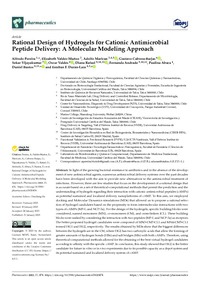Mostrar el registro sencillo de la publicación
Rational design of hydrogels for cationic antimicrobial peptide delivery: a molecular modeling approach
| dc.contributor.author | Pereira, Alfredo | |
| dc.contributor.author | Valdés-Muñoz, Elizabeth | |
| dc.contributor.author | Marican, Adolfo | |
| dc.contributor.author | Cabrera-Barjas, Gustavo | |
| dc.contributor.author | Vijayakumar, Sekar | |
| dc.contributor.author | Valdés, Oscar | |
| dc.contributor.author | Rafael, Diana | |
| dc.contributor.author | Andrade, Fernanda | |
| dc.contributor.author | Abaca, Paulina | |
| dc.contributor.author | Bustos, Daniel | |
| dc.contributor.author | Durán-Lara, Esteban F. | |
| dc.date.accessioned | 2023-03-29T12:29:36Z | |
| dc.date.available | 2023-03-29T12:29:36Z | |
| dc.date.issued | 2022 | |
| dc.identifier.uri | http://repositorio.ucm.cl/handle/ucm/4587 | |
| dc.description.abstract | In light of the growing bacterial resistance to antibiotics and in the absence of the development of new antimicrobial agents, numerous antimicrobial delivery systems over the past decades have been developed with the aim to provide new alternatives to the antimicrobial treatment of infections. However, there are few studies that focus on the development of a rational design that is accurate based on a set of theoretical-computational methods that permit the prediction and the understanding of hydrogels regarding their interaction with cationic antimicrobial peptides (cAMPs) as potential sustained and localized delivery nanoplatforms of cAMP. To this aim, we employed docking and Molecular Dynamics simulations (MDs) that allowed us to propose a rational selection of hydrogel candidates based on the propensity to form intermolecular interactions with two types of cAMPs (MP-L and NCP-3a). For the design of the hydrogels, specific building blocks were considered, named monomers (MN), co-monomers (CM), and cross-linkers (CL). These building blocks were ranked by considering the interaction with two peptides (MP-L and NCP-3a) as receptors. The better proposed hydrogel candidates were composed of MN3-CM7-CL1 and MN4-CM5-CL1 termed HG1 and HG2, respectively. The results obtained by MDs show that the biggest differences between the hydrogels are in the CM, where HG2 has two carboxylic acids that allow the forming of greater amounts of hydrogen bonds (HBs) and salt bridges (SBs) with both cAMPs. Therefore, using theoretical-computational methods allowed for the obtaining of the best virtual hydrogel candidates according to affinity with the specific cAMP. In conclusion, this study showed that HG2 is the better candidate for future in vitro or in vivo experiments due to its possible capacity as a depot system and its potential sustained and localized delivery system of cAMP | es_CL |
| dc.language.iso | en | es_CL |
| dc.rights | Atribución-NoComercial-SinDerivadas 3.0 Chile | * |
| dc.rights.uri | http://creativecommons.org/licenses/by-nc-nd/3.0/cl/ | * |
| dc.source | Pharmaceutics, 15(2), 474 | es_CL |
| dc.subject | Cationic antimicrobial peptides | es_CL |
| dc.subject | Hydrogels | es_CL |
| dc.subject | Molecular docking | es_CL |
| dc.subject | Molecular dynamics simulations | es_CL |
| dc.subject | Virtual-screening | es_CL |
| dc.subject | Antibiotic resistance | es_CL |
| dc.title | Rational design of hydrogels for cationic antimicrobial peptide delivery: a molecular modeling approach | es_CL |
| dc.type | Article | es_CL |
| dc.ucm.facultad | Facultad de Ciencias Agrarias y Forestales | es_CL |
| dc.ucm.indexacion | Scopus | es_CL |
| dc.ucm.indexacion | Isi | es_CL |
| dc.ucm.uri | mdpi.com/1999-4923/15/2/474 | es_CL |
| dc.ucm.doi | doi.org/10.3390/pharmaceutics15020474 | es_CL |



